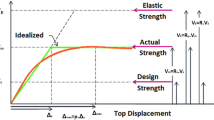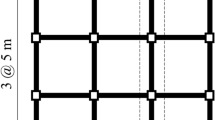Abstract
Among the methods for evaluating the nonlinear performance of structures, pushover analysis is an appropriate alternative instead of direct time history analysis. To accurately extract the capacity curve of a structure, according to the loading regulations/protocols such as FEMA-356 and ATC-40, lateral loads are incrementally applied to the structure in experimental tests until the structural failure occurs. Because of the cost and time-consuming nature of experimental tests, proposing mathematical/analytical methods could be the appropriate tools to predict the capacity curves of a system. The present study proposes a new method to find the capacity curves of cantilever steel beams based on mathematical formulations, structural analysis, and material properties. The reason to select a simple beam in this study is to shed more light on the unknown aspects of the system’s behavior. Therefore, in this research, the effect of axial load is ignored to clarify the nonlinear behavior of complicated systems such as frames. The strains, stresses, and other responses corresponding to large geometric deformations have been extracted in two cases with and without strain hardening by considering changes in the behavior of materials. The proposed method has been verified using the finite-element method with Abaqus software. The results indicate that the proposed method has acceptable accuracy and could be applied in the pushover analysis of steel structures.










Similar content being viewed by others
Abbreviations
- \({L}_{u}\) :
-
The length of the beam between the point with \({M}_{y}\) and the support
- \({\theta }_{u}\) :
-
Rotation of \({L}_{u}\)
- \({\theta }_{y-B}\) :
-
The rotation of elastic length of the beam in failure
- \({\theta }_{P}\) :
-
Rotation of LP
- \({\theta }_{y-P}\) :
-
Rotation of the elastic length of the beam at the point of plastification of the support
- \({L}_{P}\) :
-
The length of the beam between the point with My and the support for the status of plastification
- \({\delta }_{y}\) :
-
Displacement of the free end of the beam due to deformation of the elastic length of the beam at the point of plastification of the support
- \({\Delta }_{P}\) :
-
Displacement of the free end of the beam caused by \({P}_{P}\)
- \({\Delta }_{y}\) :
-
Displacement of the free end of the beam when the support reaches the yielding moment
- \({\Delta }_{H}\) :
-
Horizontal displacement of the free end of the beam
- \(S\) :
-
Elastic section modulus
- \(Z\) :
-
Plastic section modulus
- \({\varepsilon }_{y}\) :
-
Yield strain
- \({\varepsilon }_{U}\) :
-
Strain at the farthest fiber of the section corresponding to the flexural moment of the section failure
- \({\mu }_{\theta }\) :
-
Rotational ductility of the beam
- \(E\) :
-
Modulus of elasticity in the elastic region
- \({\varepsilon }_{hs}\) :
-
Strain at the final stress \(\left({F}_{U}\right)\)
- \({P}_{U}\) :
-
Collapse load
- \({M}_{U}\) :
-
Collapse moment
- \({M}_{P}=Z*{F}_{y}\) :
-
Plastic moment
- \({F}_{U}\) :
-
The final stress of steel under tension
- \({P}_{p}\) :
-
The load that causes plastic moment at the support
- \({P}_{y}\) :
-
The load that causes yielding moment at the support
- \({\Delta }_{u}\) :
-
Displacement of point B due to plastic deformation
- \({\Delta }_{y-B}\) :
-
Displacement of the free end of the beam due to the deformation of the elastic length of the beam at the point of beam failure
- \(\Delta\) :
-
Displacement of the free end of the beam under \(P\)
- \({\delta }_{P}\) :
-
Displacement of the free end of the beam due to only the plastification of the beam at the support
- \({\mathrm{A}}_{g}\) :
-
Area of the beam cross-section
- \({M}_{y}=S*{F}_{y}\) :
-
Yielding moment
- \(\uptheta\) :
-
Rotation of the whole beam length
- \(d\) :
-
Beam cross-section depth
- \({\varepsilon }_{P}\) :
-
Strain in the farthest section of fiber corresponding to the plastic flexural moment
- \({\mu }_{\varnothing }\) :
-
Cross-sectional ductility based on curvature (material properties)
- \({\mu }_{\Delta }\) :
-
Displacement ductility
- \({\varepsilon }_{h}\) :
-
Strain at the end of the steel–plastic step
References
Abaqus finite element analysis program. V. 6.14-3.
Boeraeve, P., Lognard, B., Janss, J., Gerardy, J. C., & Schleich, J. B. (1993). Elasto-plastic behaviour of steel frameworks. Journal of Constructional Steel Research, 27(1–3), 3–21.
Chen, W. F., & Sohal, I. (2013). Plastic design and second-order analysis of steel frames. Springer.
Chen, Z., Liu, J., & Yu, Y. (2017). Experimental study on interior connections in modular steel buildings. Engineering Structures, 147, 625–638.
Chopra, A. K., & Goel, R. K. (2002). A modal pushover analysis procedure for estimating seismic demands for buildings. Earthquake Engineering & Structural Dynamics, 31(3), 561–582.
Di Re, P., Bernardini, D., Ruta, D., & Paolone, A. (2022). A simple numerical approach for the pushover analysis of slender cantilever bridge piers taking into account geometric nonlinearity. Asian Journal of Civil Engineering, 23(4), 455–469.
Fajfar, P., & Fischinger, M. (1988, August). N2-A method for non-linear seismic analysis of regular buildings. In Proceedings of the ninth world conference in earthquake engineering (Vol. 5, pp. 111–116).
Ferrario, F., Iori, F., Pucinotti, R., & Zandonini, R. (2016). Seismic performance assessment of concentrically braced steel frame buildings with high-strength tubular steel columns. Journal of Constructional Steel Research, 121, 427–440.
Freeman, S. A. (1975). Evaluations of existing buildings for seismic risk-A case study of Puget Sound Naval Shipyard. In Proc. 1st US Nat. Conf. on Earthquake Engrg., Bremerton, Washington, 1975 (pp. 113–122).
Gioncu, V., & Mazzolani, F. (2003). Ductility of seismic-resistant steel structures. CRC Press.
Izadinia, M., Rahgozar, M. A., & Mohammadrezaei, O. (2012). Response modification factor for steel moment-resisting frames by different pushover analysis methods. Journal of Constructional Steel Research, 79, 83–90.
Kassimali, A. (2018). Structural analysis. Cengage Learning.
Krawinkler, H., & Seneviratna, G. D. P. K. (1998). Pros and cons of a pushover analysis of seismic performance evaluation. Engineering Structures, 20(4–6), 452–464.
Lian, M., & Su, M. (2017). Seismic performance of high-strength steel fabricated eccentrically braced frame with a vertical shear link. Journal of Constructional Steel Research, 137, 262–285.
Moghadam, A. S. (2002). A pushover procedure for tall buildings, proc. In 12th European Conference on Earthquake.
Moghadam, A. S., & Tso, W. K. (2000). 3-D pushover analysis for damage assessment of buildings.
Panandikar, N., & Narayan, K. B. (2015). Sensitivity of pushover curve to material and geometric modelling—an analytical investigation. In Structures, 2, 91–97.
Peng, J., Hou, C., & Shen, L. (2021). Lateral resistance of multi-story modular buildings using tenon-connected inter-module connections. Journal of Constructional Steel Research, 177, 106453.
Popov, E. P. (1990). Engineering mechanics of solids.
Saiidi, M., & Sozen, M. A. (1981). Simple nonlinear seismic analysis of R/C structures. Journal of the Structural Division, 107(5), 937–953.
Shamivand, A., & Akbari, J. (2020). Ring-shaped lateral bracing system for steel structures. International Journal of Steel Structures, 20(2), 493–503.
Shibaca, A., & Sozen, J. M. (1976). Substitute structure method for seismic design in reinforced concrete. Journal of Structural Engineering, 102, 1–18.
Xian, L., Liu, H., Zhao, Z., & Zhang, N. (2020). Assessing seismic collapse safety and retrofitting low-ductility RC frame structures on the basis of the acceptable collapse safety margin in China. Applied Sciences, 10(4), 1238.
Zhao, B., Zhou, T., Chen, Z., Yu, J., Yan, X., Zheng, P., & Zhao, Z. (2017). Experimental seismic behavior of SCFRT column chevron concentrically braced frames. Journal of Constructional Steel Research, 133, 141–155.
Zhao, Z., Liu, H., Liang, B., & Sun, Q. (2019). Semi-rigid beam element model for progressive collapse analysis of steel frame structures. Proceedings of the Institution of Civil Engineers-Structures and Buildings, 172(2), 113–126.
Acknowledgements
The second author acknowledged the support of Malayer University when he was an assistant professor of civil engineering from September 2008 to June 2019.
Funding
For the preparation of this manuscript and conducting this research, no fund was received.
Author information
Authors and Affiliations
Contributions
The first and second authors proposed the formulation in this paper. The third author helped to write the manuscript and draw figures. The second author edited the manuscript and submitted it to the journal.
Corresponding author
Ethics declarations
Conflict of interest
On behalf of all the authors of this paper, the corresponding author declares and guarantees that there is no conflict of interest.
Additional information
Publisher's Note
Springer Nature remains neutral with regard to jurisdictional claims in published maps and institutional affiliations.
Rights and permissions
About this article
Cite this article
Shamivand, A., Akbari, J. & Allahyari, P. An analytical formulation to extract the capacity curve of steel structures. Asian J Civ Eng 23, 1183–1195 (2022). https://doi.org/10.1007/s42107-022-00472-6
Received:
Accepted:
Published:
Issue Date:
DOI: https://doi.org/10.1007/s42107-022-00472-6




